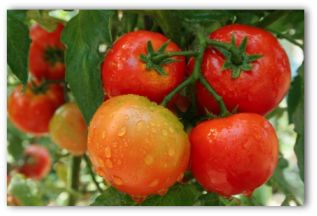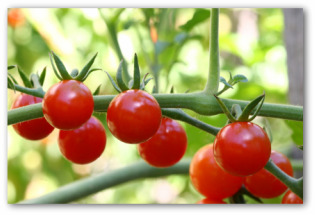Watering Tomato Plants
For Best Results

The best tips for watering tomato plants in backyard vegetable gardens?
Learn how much and how frequently to water when planting tomato plants in the garden!
Design Your Own Vegetable Garden Layout Using our Free "Vegetable Garden Planner" Software!
When and how much to water tomatoes are two big questions for beginning gardeners.
Watering these plants sufficiently is important because tomatoes grow in full sun and use and lose more water than plants grown in the shade.
Tomatoes need plenty of water especially during the early growth, flowering, and setting fruit cycle, because they grow so fast.
During this cycle, make certain to water the soil before it dries out.
Download Free Garden Planning Worksheets, Garden Diary, Zone Chart, Or Planting Guide
Watering Tomatoes
with Saved Rainwater
Using rainwater is typically recommended as the healthiest technique with tomatoes.
You can also use tap water or follow traditional recycling practices.
In the "olden days", gardeners caught rainwater in water barrels and tubs and used this to water the vegetable garden.
Water that had been used for cooking, washing, or cleaning, was sloshed onto the soil.
These watering practices can still be useful today if you follow careful storage and use guidelines.

Watering Tomato Plants with Warm Water
"Tomatoes need water quite warm."
Many traditional gardeners still follow this vegetable gardening guideline handed down through the generations.
The saying stems from the belief that watering plants with very cold water is too much of a shock to their system.
Greenhouse plants like warm water because it reflects the temperature of their environment.
If you have to transplant or plant tomato plants on a cool day, puddle the roots in warm water first
Vegetable Gardening Tips for Watering Tomatoes
Although, rainwater is certainly better for watering your tomato plants than tap water in hard water areas with high calcium deposits, stagnant water can be dangerous.
Cover your water storage container.
Exposure to light will turn it stagnant quickly in hot, dry weather conditions.
Stagnation breeds bacteria that can spread plant diseases, which may prevent the roots from soaking up the necessary nutrients.
Using Tap Water when Watering Tomato Plants
If you do not have any rainwater collected, run tap water into a watering can and allow it to settle for an hour or two before watering tomato plants.
This allows any chlorine present in the water to evaporate before using it on young plants.

Recycling Water
Never use gray-water, which is dishwater or bathwater, when watering tomato plants.
Gray-water contains household detergents and soaps that adversely affect the soil.
The chemicals and bleach in gray-water hinders the ability of plants to soak in nutrition and may contaminate the water table as well.
Water-Conserving Devises
Garden centers sell all sorts of water-conserving devices for use when vegetable gardening.
However, you can make your own.
Soaker or seep hoses are a good option, especially in beds of vegetables.
Pierce a length of hose with tiny pinprick holes along its length and lay it among your plants, attaching one end to the faucet.
Soaker hoses work best in short lengths.
Drip Systems for Watering Tomatoes
- Installing a drip system to water your vegetable garden plants is a great way to go.
- Drip systems conserve water, and offer a slow steady supply of water to the tomato plant without disturbing the plant root system.
- It is actually very easy to install a drip system, so don't be overwhelmed by the idea!
- Adding a timer to the drip system will allow you to water your garden automatically at the same time each day, or every other day as desired.
Add Mulch to Conserve Water
- Adding a 2-3 inch layer of organic mulch to the topsoil of your garden will help prevent the soil from drying too quickly through evaporation.
- Mulching also is an effective way of adding slow-release fertilizer or nutrients to your garden plants each time you water.
How Much Water is Enough?
In general, most vegetable garden plants, including tomato plants, require about 1" of water per week.
During especially hot dry weather, or if you haven't added a layer of mulch to prevent evaporation, it may be necessary to water an extra half-inch per week.
Many expert gardeners greatly reduce the amount of water to their tomatoes after the plants have reached maturity and have set fruit.
The idea behind this is that stressing the plants a bit encourages fruit to develop more quickly.
I think this technique is helpful, but is not absolutely necessary if it is not convenient for you to do this.
How to Water Tomatoes While You're on Vacation
Again, installing a drip watering system on a timer is the best way to ensure regular and adequate water for your vegetable garden.
If you don't have a drip system, there are several other workable, but less convenient ways to do this.
If you cannot find a neighbor to entrust with watering your tomato plants while you are away for a few days, help your precious tomato plants by mulching well and covering the plants with straw for insulation.
Place container-grown tomato plants in buckets or trays of shallow water until your return.
Enlivened Water
Some bio-dynamic gardeners follow an ancient practice of enlivening the water for their gardens.
They take a tub of rainwater and stir it with a wooden spoon clockwise for 40 turns.
This method is justified by modern science because water that goes through a spiraling shape picks up energy.
Watering tomato plants with water that is energized promotes healthier growth.
Watering Tomato Plants to Vegetable Gardening

